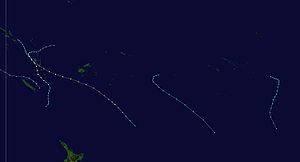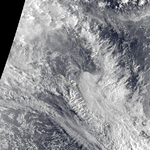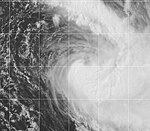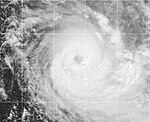2000–01 South Pacific cyclone season
| 2000–01 South Pacific cyclone season | |
|---|---|

Season summary map
|
|
| Seasonal boundaries | |
| First system formed | December 11, 2000 |
| Last system dissipated | May 9, 2001 |
| Strongest storm | |
| Name | Paula |
| • Maximum winds | 175 km/h (110 mph) (10-minute sustained) |
| • Lowest pressure | 930 hPa (mbar) |
| Seasonal statistics | |
| Total disturbances | 16 |
| Total depressions | 11 |
| Tropical cyclones | 4 |
| Severe tropical cyclones | 1 |
| Total fatalities | 7 total |
| Total damage | $800,000 (2001 USD) |
| Related articles | |
| Tropical depression (Australian scale) | |
| Duration | December 11 – December 15 |
|---|---|
| Peak intensity | 65 km/h (40 mph) (10-min) 993 hPa (mbar) |
| Tropical depression (Australian scale) | |
| Tropical storm (SSHWS) | |
| Duration | February 16 (entered basin) – February 18 |
|---|---|
| Peak intensity | 55 km/h (35 mph) (10-min) 993 hPa (mbar) |
| Category 2 tropical cyclone (Australian scale) | |
| Tropical storm (SSHWS) | |
| Duration | February 20 – February 22 |
|---|---|
| Peak intensity | 95 km/h (60 mph) (10-min) 984 hPa (mbar) |
| Category 4 severe tropical cyclone (Australian scale) | |
| Category 3 tropical cyclone (SSHWS) | |
| Duration | February 26 – March 4 |
|---|---|
| Peak intensity | 175 km/h (110 mph) (10-min) 930 hPa (mbar) |
| Category 1 tropical cyclone (Australian scale) | |
| Tropical storm (SSHWS) | |
| Duration | February 27 – March 5 |
|---|---|
| Peak intensity | 85 km/h (50 mph) (10-min) 986 hPa (mbar) |
| Category 2 tropical cyclone (Australian scale) | |
| Category 1 tropical cyclone (SSHWS) | |
| Duration | April 5 – April 11 |
|---|---|
| Peak intensity | 110 km/h (70 mph) (10-min) 975 hPa (mbar) |
| Tropical depression (Australian scale) | |
| Duration | May 1 – May 3 |
|---|---|
| Peak intensity | 75 km/h (45 mph) (10-min) 1004 hPa (mbar) |
The 2000–01 South Pacific cyclone season was an event in the annual cycle of tropical cyclone formation. It began on November 1, 2000 and ended on April 30, 2001. These dates conventionally delimit the period of each year when most tropical cyclones form in the southern Pacific Ocean east of 160°E. Additionally, the regional tropical cyclone operational plan defines a tropical cyclone year separately from a tropical cyclone season, and the "tropical cyclone year" runs from July 1, 2000 to June 30, 2001.
Tropical cyclones between 160°E and 120°W and north of 25°S are monitored by the Fiji Meteorological Service in Nadi. Those that move south of 25°S are monitored by the Tropical Cyclone Warning Centre in Wellington, New Zealand.
During the 2000–01 South Pacific cyclone season, only four tropical cyclones and one severe tropical cyclone formed. Compared to an average season, which generally features nine tropical cyclones and four to five severe tropical cyclones, the 2000–01 season was substantially below average. The season itself began unusually late, with the first system developing on February 20; however, according to the JTWC, a brief tropical storm existed between February 16 and 18.
Two people were killed in Fiji as a result of severe flooding.
A brief tropical storm was monitored by the Joint Typhoon Warning Center just off the northern coast of New Caledonia
Cyclone Oma formed on February 20, dissipated on February 22.
Formed on February 26, dissipated on March 4.
Three people were killed by the storm, two in Vanuatu and one in Fiji. On Vanuatu, sustained winds reached 100 km/h (62 mph) and gusts were estimated at 200 km/h (120 mph). Initial reports indicated that a young boy had been swept away near Santo and was presumed dead. However, the boy was found days later clinging to a rock. The two fatalities in the country resulted from fallen tree limbs on the islands of Epi and Ambae. Following an aerial assessment of damage in Vanuatu, Malampa and Shefa provinces in were declared disaster areas. In these provinces, nearly 50% of all homes sustained damage and upwards of a quarter of all buildings were impacted. In Fiji, damage from Paula was much less than initially feared; however, several homes in the Western Division were destroyed by rough seas produced by the storm. Elsewhere, structural damage was minimal and a few landslides resulted in damage to crops. Throughout the country, preliminary estimates placed the damage at US$800,000.
...
Wikipedia










